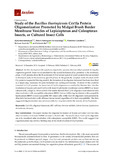Mostrar el registro sencillo del ítem
Study of the bacillus thuringiensis Cry1Ia protein oligomerization promoted by midgut brush border membrane vesicles of lepidopteran and coleopteran insects, or cultured insect cells
| dc.creator | Khorramnejad, Ayda | es_ES |
| dc.creator | Domínguez Arrizabalaga, Mikel | es_ES |
| dc.creator | Caballero Murillo, Primitivo | es_ES |
| dc.creator | Escriche, Baltasar | es_ES |
| dc.creator | Bel, Yolanda | es_ES |
| dc.date.accessioned | 2020-07-06T08:41:23Z | |
| dc.date.available | 2020-07-06T08:41:23Z | |
| dc.date.issued | 2020 | |
| dc.identifier.issn | 2072-6651 | |
| dc.identifier.uri | https://hdl.handle.net/2454/37340 | |
| dc.description.abstract | Bacillus thuringiensis (Bt) produces insecticidal proteins that are either secreted during the vegetative growth phase or accumulated in the crystal inclusions (Cry proteins) in the stationary phase. Cry1I proteins share the three domain (3D) structure typical of crystal proteins but are secreted to the media early in the stationary growth phase. In the generally accepted mode of action of 3D Cry proteins (sequential binding model), the formation of an oligomer (tetramer) has been described as a major step, necessary for pore formation and subsequent toxicity. To know if this could be extended to Cry1I proteins, the formation of Cry1Ia oligomers was studied by Western blot, after the incubation of trypsin activated Cry1Ia with insect brush border membrane vesicles (BBMV) or insect cultured cells, using Cry1Ab as control. Our results showed that Cry1Ia oligomers were observed only after incubation with susceptible coleopteran BBMV, but not following incubation with susceptible lepidopteran BBMV or non-susceptible Sf21 insect cells, while Cry1Ab oligomers were persistently detected after incubation with all insect tissues tested, regardless of its host susceptibility. The data suggested oligomerization may not necessarily be a requirement for the toxicity of Cry1I proteins. | en |
| dc.description.sponsorship | This work was supported by grants from the Spanish Ministry of Science, Innovation and Universities, the State Research Agency of Spain and the European FEDER founds (Refs. AGL2015-70584-C2 and RTI2018-095204-B-C21), and by the Generalitat Valenciana (GVPROMETEOII-2015-001). M. Domínguez received a predoctoral fellowship from the Universidad Pública de Navarra, Spain. | en |
| dc.format.extent | 15 p. | |
| dc.format.mimetype | application/pdf | en |
| dc.language.iso | eng | en |
| dc.publisher | MDPI | en |
| dc.relation.ispartof | Toxins, 2020, 12(2), 133 | en |
| dc.rights | © 2020 by the authors. Licensee MDPI, Basel, Switzerland. This article is an open access article distributed under the terms and conditions of the Creative Commons Attribution (CC BY) license. | en |
| dc.rights.uri | http://creativecommons.org/licenses/by/4.0/ | |
| dc.subject | Cry1Ab | en |
| dc.subject | Oligomer formation | en |
| dc.subject | Sf21 cell line | en |
| dc.subject | Ostrinia nubilalis | en |
| dc.subject | Lobesia botrana | en |
| dc.subject | Leptinotarsa decemlineata | en |
| dc.subject | Bioassay | en |
| dc.title | Study of the bacillus thuringiensis Cry1Ia protein oligomerization promoted by midgut brush border membrane vesicles of lepidopteran and coleopteran insects, or cultured insect cells | en |
| dc.type | info:eu-repo/semantics/article | en |
| dc.type | Artículo / Artikulua | es |
| dc.contributor.department | Agronomía, Biotecnología y Alimentación | es_ES |
| dc.contributor.department | Agronomia, Bioteknologia eta Elikadura | eu |
| dc.rights.accessRights | info:eu-repo/semantics/openAccess | en |
| dc.rights.accessRights | Acceso abierto / Sarbide irekia | es |
| dc.identifier.doi | 10.3390/toxins12020133 | |
| dc.relation.projectID | info:eu-repo/grantAgreement/MINECO//AGL2015-70584-C2-2-R/ES/ | en |
| dc.relation.publisherversion | https://doi.org/10.3390/toxins12020133 | |
| dc.type.version | info:eu-repo/semantics/publishedVersion | en |
| dc.type.version | Versión publicada / Argitaratu den bertsioa | es |
| dc.contributor.funder | Universidad Pública de Navarra / Nafarroako Unibertsitate Publikoa | es |




